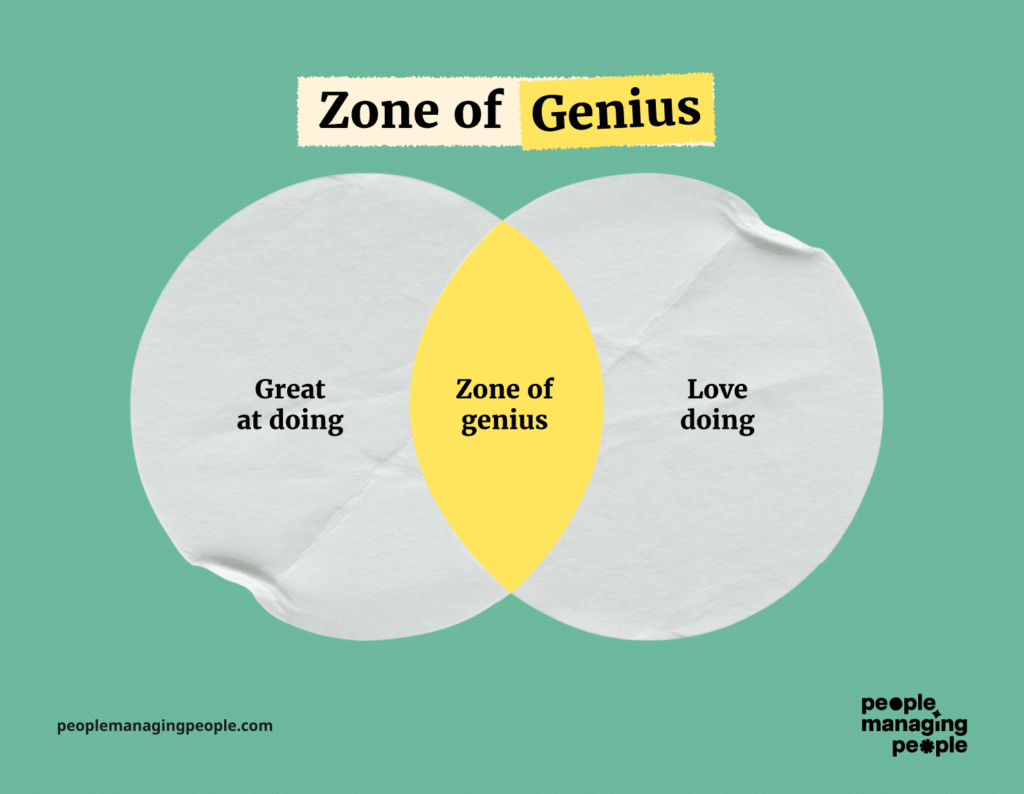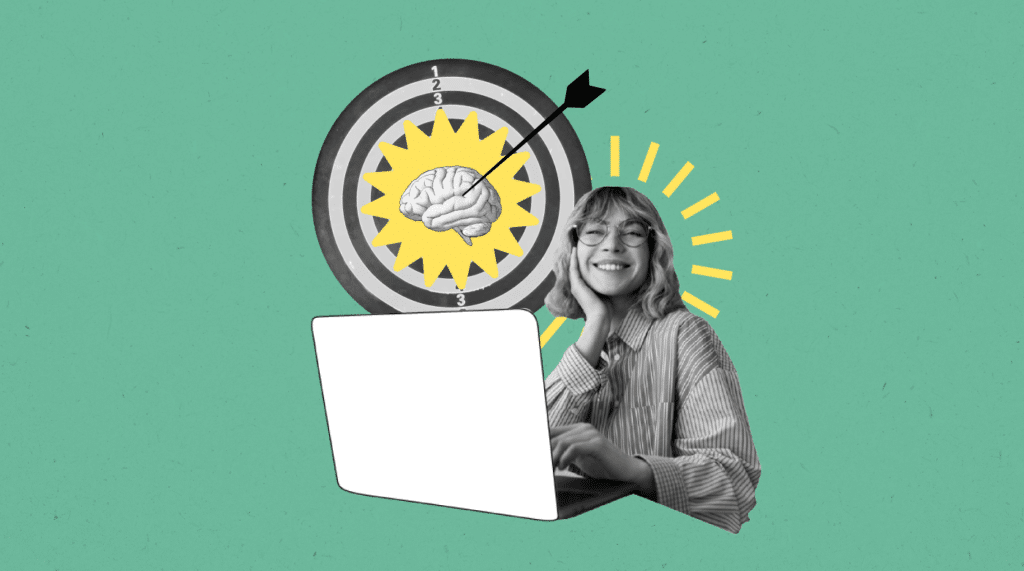Struggling to tap into your team's potential in a remote setting? Dealing with disengaged employees and the endless noise of pings, notifications and distractions?
Well, there’s a solution for everything, and that solution starts with understanding our brains and the unique environments that harness our individual Zone of Genius.
In this article, I'll guide you through tapping into the deeper alignment of self that drives true productivity, despite our noisy, distraction-filled world.
What is the Zone of Genius?
I first learned about the concept of Zone of Genius in Gay Hendricks’ book, The Big Leap. He describes four “zones” in which all individuals operate:
- Zone of Incompetence: Tasks we're not good at, which others can do better.
- Zone of Competence: Tasks we can do adequately, but so can many others.
- Zone of Excellence: Tasks we do exceptionally well, often what we're known for or have built a career around. However, work in this zone might not fulfill us because it doesn't tap into our unique strengths or passions.
- Zone of Genius: The activities we're uniquely suited to do, that draw upon our innate talents and passions. It’s where we’re not just competent or even excellent, but we’re doing something that feels almost like a calling. In this zone, work doesn’t feel like work because we’re so aligned with what we’re doing holistically that it physically, emotionally and intellectually energizes us.
I’m someone who doesn’t believe in doing anything unless I’m all in, so naturally I’ve become obsessed with learning as much as I can about how to create remote working environments where folks are able to do their best work and concurrently live their best lives: aka being in their Zone of Genius as much as humanly possible.
Turns out, it’s good for business too!
People are more holistically productive in this unique state than when they do anything else. For me, that’s creating and innovating ways to enhance connection and engagement in the new world of work, and for you, well only you know your unique genius zone, we all have one.

Reflect on when you last felt deeply engaged and energized by your work. Can you identify a specific moment? What about the physical environment you were in? This feeling is key to identifying your Zone of Genius.
Understanding The Brain And Productivity
To harness the power of your Zone of Genius (something already inside of you), especially in a remote setting, it’s crucial to understand the brain states that foster peak productivity and allow you to actually access that zone. Our brains are not static, they’re highly dynamic and are highly influenced by our environment, habits and mindset.
The optimal brain state for productivity
While neuroscience shows our most productive states occur in 'flow,' achieving this in our always-on, multitasking reality is increasingly rare. Flow requires immersion and focus—qualities often disrupted by constant notifications and the blending of work with personal life.
‘Flow’ is characterized by a complete immersion and focus on the task at hand, where time seems to fly and productivity skyrockets. Achieving flow requires a balance between the challenge of the task and our skill level, ensuring we’re neither bored nor overwhelmed.
Also, this state can only be achieved when we’re not constantly context switching, like checking slack every 5 minutes for fear the business is on fire (it’s not).
The role of the prefrontal cortex
The prefrontal cortex plays a pivotal role in our ability to focus and make decisions. When we're engaged in work that aligns with our Zone of Genius, we're likely leveraging this part of the brain.
Now, envision a team operating at its peak because leaders have actively asked for, mapped out and engaged each person's strengths and passions vs. following an outdated job description or generic task list.
This scenario isn't about the passive alignment leaders often fall into out of habit, but about intentionally creating a vibrant, action-driven environment. It comes to life through leaders who invest in understanding their team's unique work styles, then actively assign tasks to ignite the prefrontal cortex.
Try this approach and watch it lead to sharper focus, more decisive action, and a surge in innovative outcomes.
Don’t let stress kill your creativity
Chronic stress can be a creativity, productivity and profit killer. It triggers the release of cortisol, which in high levels, can impair cognitive functions and hinder our ability to engage in any sort of creative thinking or problem-solving.
However, the solution isn't found in pushing harder or staying "on" longer. Science-backed techniques like mindfulness meditation, regular physical activity, and deep-breathing exercises are proven strategies to manage stress, bolstering your brain's resilience and performance capacity.
These aren't fringe or 'woo-woo' practices but essential tools recognized by neuroscience for maintaining cognitive health and enhancing creativity.
Embarking on this path may initially seem unconventional within the context of traditional work habits. However, prioritizing these evidence-based strategies for stress management not only benefits personal well-being but also sets a precedent for fostering a more creative, productive, and resilient workplace culture.
SHIFTing Into The Zone
In the era of remote work, diving into our Zone of Genius requires so much more than just discipline and going to the mental gym. It demands a deep understanding of our brain's workings and how we architect our company cultures (sans the office).
The S.H.I.F.T framework integrates neuroscience to help you create environments where individual and team cognitive capabilities can flourish. Here's how you can apply each aspect with a neuroscientific lens.
S = Set Clear Expectations: The Neuroscience of Clarity
Neuroscientifically, our brains thrive on clarity. The prefrontal cortex, responsible for planning complex cognitive behavior and decision-making, functions best when goals and expectations are well-defined.
By setting clear expectations for ourselves and our teams, we reduce cognitive load, making it easier to focus on tasks that align with our Zone of Genius. This clarity fosters a mental environment where creativity and productivity can bloom.
It’s not enough to tell people “we’re flexible, work whenever you want!” Get clear, define simple swim lanes like working and time zone overlap specifications, and allow that clarity to spark innovation.
H = Harness the Tools: Optimizing for Cognitive Compatibility
Choosing the right tools should always be about cognitive compatibility. Each app or platform we use can either enhance our brain's ability to focus or add to the cognitive clutter.
When selecting tools for remote work, consider their impact on your attention and mental energy. Tools that support asynchronous communication, for example, can help mitigate the 'always-on' stress that impairs our prefrontal cortex's functioning, preserving our cognitive resources for more meaningful work.
Try starting with simply categorizing the tools your team already uses, providing clarity to team members on where to go for what type of information.

I = Inspire Engagement: Dopamine and Social Connection
Our brains are wired to seek social connection, releasing dopamine—a neurotransmitter associated with pleasure and motivation—when we interact with others in meaningful ways.
In remote work settings, fostering a sense of community and shared purpose can boost this neurochemical reward, enhancing engagement and satisfaction. Create opportunities for your team to connect not just on work tasks but on personal growth and achievements, tapping into the neurobiology of belonging and motivation.
It doesn’t have to be overwhelming - steal a few ideas from this worksheet below and experiment with what works best for your team and culture!

F = Foster Well-being: Breathwork and the Autonomic Nervous System
Breathwork is so much more than a relaxation technique, it's a neuroscience-backed method to regulate the autonomic nervous system, shifting from the stress-induced 'fight or flight' response to a calmer 'rest and digest' state.
The shift is crucial for creative thinking and problem-solving. Integrating breathwork into your personal or team routine can help maintain the mental balance necessary for accessing your Zone of Genius.
While it may seem strange to start a meeting off with 2 minutes of box breathing, it can actually set the tone for a calmer, more productive conversation.
T = Train the Brain: The Plasticity of Productivity
Our brains are remarkably adaptable, thanks to neuroplasticity—the ability to form new neural connections throughout life.
Embracing new habits, learning new skills, and regularly challenging ourselves can strengthen the neural pathways associated with focus, creativity, and resilience. Encourage your team to embrace challenges and continuous learning as a way to 'train' their brains, enhancing their capacity to enter and sustain periods of flow, where their Zone of Genius lies.
Like we talked about earlier, permission drives performance so the more space you give yourself and team to experiment with different environments, modes of working, communication and types of rest, the better off everyone will be.
The World We Want To Build
By weaving neuroscience into the fabric of forward-thinking remote work strategies, the S.H.I.F.T framework becomes not just a method for productivity but a holistic approach to cultivating work environments that resonate with our deepest cognitive and emotional needs.
Tapping into your Zone of Genius, especially in a remote work setting, isn't just about doing more, it's about doing what you're best at, more effectively. By understanding and leveraging the neuroscience of productivity, we can create a work life that's not only more productive but also more satisfying and fulfilling.
The S.H.I.F.T framework is your toolkit for this transformation, guiding you to redefine the essence of remote work. Dive into 15+ made for you templates and eliminate the stress and expense of coming up with exercises and science backed activities yourself.
In the world I’m trying to build, I don’t just want to work remotely, I want to be in my Zone of Genius, working alongside others who have harnessed theirs, in pursuit of making the world a better place, one genius at a time.
Want to learn from fellow HR and people ops pros who are working mindfully to access their zone of genius every day? Join the People Managing People community of leaders and practitioners trying to create the workplaces of tomorrow.


